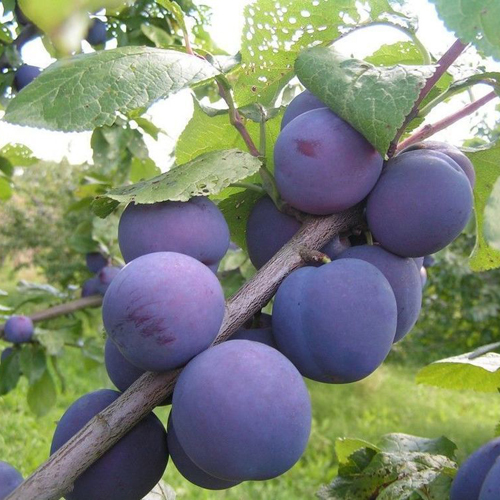Plum variety Blue Dar
Plum is one of the most unpretentious fruit crops. For lovers of this fruit, many varieties have been bred, for every taste and color. The Blue Dar variety appeared at the All-Russian Institute of Selection and Technology of Horticulture and Nursery. Authors - S.N. Satarov and V.S. Smirnov. The genetic basis was Ochakovskaya and Pamyat Timiryazev. In 1992, an application was submitted for registration of the variety in the State Register of Plants of the Russian Federation. In 2001, plum was included in it with admission to cultivation in the Central region of the country (Tula, Ryazan, Moscow, Smolensk, Ivanovskaya, Kaluga, Bryansk, Vladimir regions). The blue gift has taken root well in the south, and according to some reports, it is very popular in the Moscow region. After variety trials, it was found suitable for large-scale production and intensive gardening.

Description
The size of the tree is small, about 3 meters in height, which makes maintenance very easy. The crown is rounded-oval, slightly raised, with moderate foliage and density. Young, arched shoots are covered with gray-brown, slightly pubescent bark. The stem is about 60 cm high or slightly higher, covered with gray rough bark. Buds of a medium-sized variety, deviated from the shoot. Leaves are dark green, obovate, slightly elongated, with a serrate-edged edge. The size of the sheet plate (length x width) is 38.7 sq. see The surface of the plum leaf is slightly wrinkled, smooth, matte, there is a slight pubescence on the underside. The petiole is ordinary, with two glands. The flowers of the Blue Gift are white, five-petaled. The petals are not closed, the number of stamens is 18, they are located just below the stigma of the pistil. Pedicel is ordinary, glabrous, calyx-shaped, ovary glabrous. Flowering and fruiting occurs on annual shoots and bouquet branches.
The drupes are oval in shape, one-dimensional, weight - 14 - 17 grams. The apex and base are oval, the ventral suture is poorly developed. The surface is smooth, without pubescence. The skin is dense, the main color is dark purple, the integumentary is absent, the wax coating densely covers the entire surface. The pulp of the plum fruit is juicy, grainy-fibrous, rather dense, the color is greenish-yellow. The taste is sweet and sour. Assessment of tasters - 3.8 points. 100 grams of pulp contains: dry matter 13.5%, sugar 7.6%, acids 2.4%, vitamin C 7 mg /%. An oval stone, weighing 1 gram, is almost 7.1% of the total weight of the fruit. The bone lags behind the pulp satisfactorily. Peduncle of moderate length and thickness. The separation is dry.
Characteristics
- At the time of fruiting, the Blue Gift enters quite quickly - in the 4th year, the field of planting with an annual seedling;
- blooms early - May 12 - 19. At this time, in the Moscow region, the main late spring frosts have already passed, so the flowers, as a rule, do not suffer;
- a variety of medium ripening - the fruits ripen in mid-August, in the conditions of the Moscow region this happens on August 16 - 24;
- from the 4th year, the tree brings about 8 kg of fruit, then - about 14 kg. According to the State Register of Plants of the Russian Federation, the average yield for the period of variety trials from 1995 to 2000 was 61 c / ha. At the time when the fruits are ripe, the plum looks very beautiful and looks like sea buckthorn - there are so many fruits on the branches;
- the duration of the productive life of the Blue Gift is more than 20 years;
- fruiting of the tree is regular. Over the past 16 years, only 4 lean years have been recorded, following severe winters;
- the variety is highly self-fertile, no pollinator is required;
- the variety is relatively frost-resistant. Shoots and branches are moderately damaged by frost. Flower buds are less damaged;
- drought resistance of the plant is moderate;
- The blue gift is moderately affected by clasterosporiosis and fruit rot (by about 2 - 3.5 points). It suffers to a greater extent from pests, moths and aphids, the lesion is 3-4 points;
- plum is vulnerable to bark cracking. This can happen during periods of sharp temperature fluctuations at the time of intensive tree growth;
- fruits are highly transportable and well stored;
- the way of using the fruits is universal. Fruit can be consumed in its natural form or processed. Evaluation of cooked jam, jam, compotes, wine - 4.3 points.
Planting and leaving
Landing in the Central Region can be done in spring and autumn. The soils should be loose, moisture and oxygen permeable. You need to choose a place for planting that is secluded, protected from the wind, preferably in the southern or southeastern part of the garden. The more sun, the sweeter the fruit will be.
Leaving is not difficult. Watering up to 4 times per growing season (including pre-winter irrigation). Loosening should be carried out after moistening. Nitrogen-containing dressings are preferred in spring, potassium and phosphorus in autumn. Plum pruning is carried out as needed.
The blue gift is a reliable and productive crop with fruits of universal use. This variety is especially appreciated for the self-fertility and winter hardiness of flower buds.








